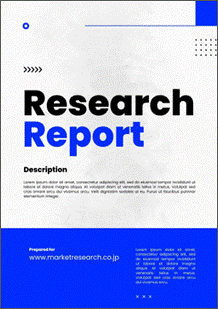 | • レポートコード:MRC2303B121 • 出版社/出版日:Mordor Intelligence / 2023年1月 • レポート形態:英文、PDF、120ページ • 納品方法:Eメール(受注後2-3営業日) • 産業分類:化学 |
| Single User | ¥703,000 (USD4,750) | ▷ お問い合わせ |
| Corporate License | ¥1,295,000 (USD8,750) | ▷ お問い合わせ |
• お支払方法:銀行振込(納品後、ご請求書送付)
レポート概要
| Mordor Intelligence社の本市場調査レポートでは、世界の排出ガス浄化触媒市場規模が、予測期間中(2022年~2027年)に年平均5%で成長すると展望しています。本書は、排出ガス浄化触媒の世界市場について総合的に分析し、イントロダクション、調査手法、エグゼクティブサマリー、市場動向、金属別(プラチナ、パラジウム、ロジウム、その他)分析、用途別(移動型排ガス浄化触媒、定置型排ガス浄化触媒)分析、産業別(自動車、工業、その他)分析、地域別(中国、インド、日本、韓国、東南アジア、アメリカ、カナダ、メキシコ、ドイツ、イギリス、イタリア、フランス、ロシア、ブラジル、アルゼンチン、サウジアラビア、UAE、南アフリカ)分析、競争状況、市場機会・将来の動向などの項目を整理しています。さらに、参入企業として、Aerinox-Inc.、BASF SE、CDTi Advanced Materials Inc.、Clariant、CORMETECH、DCL International Inc.、Evonik Industries AG、Haldor Topsoe A/S、Hitachi Zosen Corporation、IBIDEN Ceram GmbH、JGC C&C、Johnson Matthey、Nikki-Universal Co. Ltd、Umicoreなどの情報を含んでいます。 ・イントロダクション ・調査手法 ・エグゼクティブサマリー ・市場動向 ・世界の排出ガス浄化触媒市場規模:金属別 - プラチナの市場規模 - パラジウムの市場規模 - ロジウムの市場規模 - その他の市場規模 ・世界の排出ガス浄化触媒市場規模:用途別 - 移動型排ガス浄化触媒における市場規模 - 定置型排ガス浄化触媒における市場規模 ・世界の排出ガス浄化触媒市場規模:産業別 - 自動車における市場規模 - 工業における市場規模 - その他における市場規模 ・世界の排出ガス浄化触媒市場規模:地域別 - アジア太平洋の排出ガス浄化触媒市場規模 中国の排出ガス浄化触媒市場規模 インドの排出ガス浄化触媒市場規模 日本の排出ガス浄化触媒市場規模 … - 北米の排出ガス浄化触媒市場規模 アメリカの排出ガス浄化触媒市場規模 カナダの排出ガス浄化触媒市場規模 メキシコの排出ガス浄化触媒市場規模 … - ヨーロッパの排出ガス浄化触媒市場規模 ドイツの排出ガス浄化触媒市場規模 イギリスの排出ガス浄化触媒市場規模 イタリアの排出ガス浄化触媒市場規模 … - 南米/中東の排出ガス浄化触媒市場規模 ブラジルの排出ガス浄化触媒市場規模 アルゼンチンの排出ガス浄化触媒市場規模 サウジアラビアの排出ガス浄化触媒市場規模 … - その他地域の排出ガス浄化触媒市場規模 ・競争状況 ・市場機会・将来の動向 |
The market for emission control catalysts is expected to witness a CAGR of around 5% during the forecast period. One of the major factor driving the growth of the market is the enactment of stringent emission norms.
Key Highlights
- Impact of COVID-19 pandemic is likley to hinder the growth of the market studied.
- By metal, platinum segment is likely to dominate the market studied through the forecast period.
- Asia-Pacific dominated the market with the largest consumption coming from China, ASEAN Countries, and India.
Emission Control Catalysts Market Trends
Platinum – The Most used Metal
- Platinum is the most widely used metal for emission control applications, since it improves combustion.
- Improved combustion helps to reduce emissions and enhance the catalyst’s performance.
- Since, platinum is effective under oxygen-rich conditions, it is used widely for diesel applications.
- Furthermore, platinum offers several other advantages, such as:
- It has a high melting point, thereby providing thermal durability.
- It possesses excellent oxidation activity at low temperatures.
- It is effective against sulfur compounds and helps in reducing the sulfur content in crude oil, in the refineries.
- It can be efficiently recycled.
- Sources, such as, automobiles, refinery & petrochemical complexes, chemical industries, oil and natural gas processing plants, and pharmaceutical industries, among others, are discovering an increasing number of applications of platinum-based emission control catalysts.
China to Dominate the Asia-Pacific Market
- China is one of the fastest growing economies, globally. Furthermore, almost all the end-user industries have been witnessing growth, owing to the growing population, living standards, and per capita income.
- China is a hub for chemical processing, accounting for a major chunk of the chemicals produced globally. The country contributes more than 35% of the global chemical sales. The chemical industry is another prominent end-user industry in China. Many major companies in the market have their chemical plants in China. With the growing demand for various chemicals, globally, the demand for emission control catalysts from this sector is projected to grow during the forecast period.
- Moreover, the Chinese automotive manufacturing industry is the largest in the world. Though the industry witnessed a slowdown in 2018, wherein the production and sales declined. Similar trend continued, with the production witnessing a 7.5% decline in 2019. According to the China Association of Automobile Manufacturers (CAAM), automotive production is expected to decline by about 2% in the end of 2020.
- The “Made in China 2025” initiative aims to support in upgrading the existing low-cost mass production to higher value-added advanced manufacturing. The “Automobile Mid and Long-Term Development Plan” was released in the April 2017, with an objective to make China a strong auto power in the next ten years. This growth in the automotive industry is likely to increase the consumption of emission control catalysts in the industry.
- However, due the onset of COVID-19, the economic growth of China now seems to contract by a considerable extent in 2020. Many manufacturing and associated activities have already taken a hit in early 2020, and the economic situation is expected to remain dire, if the manufacturing activities are not set back on track by mid-2020
Emission Control Catalysts Market Competitor Analysis
The global emission control catalysts market is partially consolidated in nature, with the top ten players accounting for a major share of the global market. Some of the prominent players in the market include Clariant, BASF SE, Evonik Industries AG, Johnson Matthey, and Umicore, among others.
Additional Benefits:
- The market estimate (ME) sheet in Excel format
- 3 months of analyst support
1 INTRODUCTION
1.1 Study Assumptions
1.2 Scope of the Study
2 RESEARCH METHODOLOGY
3 EXECUTIVE SUMMARY
4 MARKET DYNAMICS
4.1 Drivers
4.1.1 Enactment of Stringent Emission Norms
4.1.2 Other Drivers
4.2 Restraints
4.2.1 Impact of COVID-19 Pandemic
4.2.2 Other Restraints
4.3 Industry Value-chain Analysis
4.4 Porter’s Five Forces Analysis
4.4.1 Bargaining Power of Suppliers
4.4.2 Bargaining Power of Consumers
4.4.3 Threat of New Entrants
4.4.4 Threat of Substitute Products and Services
4.4.5 Degree of Competition
5 MARKET SEGMENTATION
5.1 Metal
5.1.1 Platinum
5.1.2 Palladium
5.1.3 Rhodium
5.1.4 Other Metals
5.2 Application
5.2.1 Mobile Emission Control Catalysts
5.2.2 Stationary Emission Control Catalysts
5.3 End-user Industry
5.3.1 Automotive
5.3.2 Industrial
5.3.3 Other End-user Industries
5.4 Geography
5.4.1 Asia-Pacific
5.4.1.1 China
5.4.1.2 India
5.4.1.3 Japan
5.4.1.4 South Korea
5.4.1.5 ASEAN Countries
5.4.1.6 Rest of Asia-Pacific
5.4.2 North America
5.4.2.1 United States
5.4.2.2 Canada
5.4.2.3 Mexico
5.4.3 Europe
5.4.3.1 Germany
5.4.3.2 United Kingdom
5.4.3.3 Italy
5.4.3.4 France
5.4.3.5 Russia
5.4.3.6 Rest of Europe
5.4.4 South America
5.4.4.1 Brazil
5.4.4.2 Argentina
5.4.4.3 Rest of South America
5.4.5 Middle-East
5.4.5.1 Saudi Arabia
5.4.5.2 United Arab Emirates
5.4.5.3 South Africa
5.4.5.4 Rest of Middle-East
6 COMPETITIVE LANDSCAPE
6.1 Mergers & Acquisitions, Joint Ventures, Collaborations and Agreements
6.2 Market Share/Ranking Analysis**
6.3 Strategies Adopted by Leading Players
6.4 Company Profiles
6.4.1 Aerinox-Inc.
6.4.2 BASF SE
6.4.3 CDTi Advanced Materials Inc.
6.4.4 Clariant
6.4.5 CORMETECH
6.4.6 DCL International Inc.
6.4.7 Evonik Industries AG
6.4.8 Haldor Topsoe A/S
6.4.9 Hitachi Zosen Corporation
6.4.10 IBIDEN Ceram GmbH
6.4.11 JGC C&C
6.4.12 Johnson Matthey
6.4.13 Nikki-Universal Co. Ltd
6.4.14 Umicore
7 MARKET OPPORTUNITIES AND FUTURE TRENDS